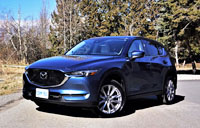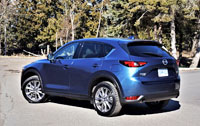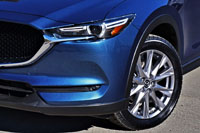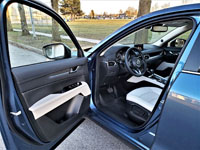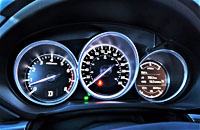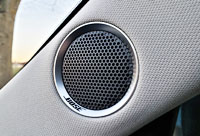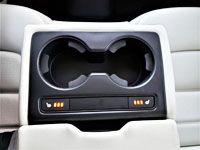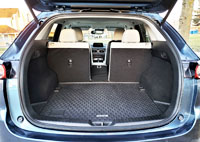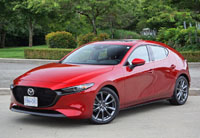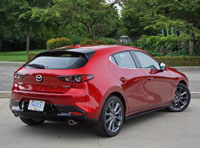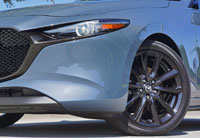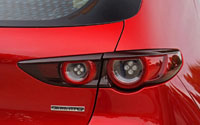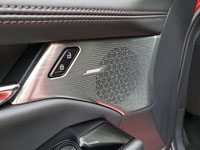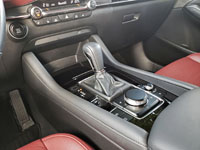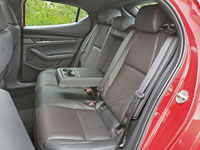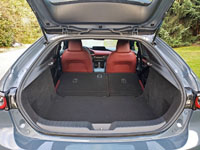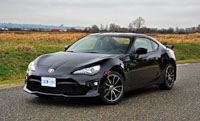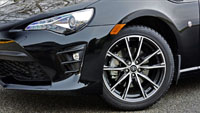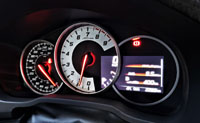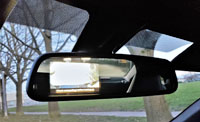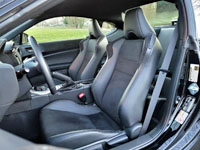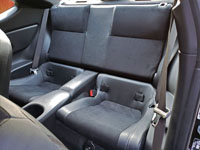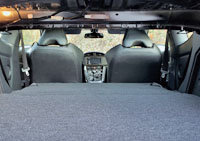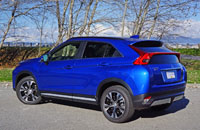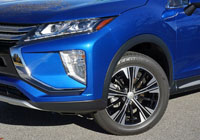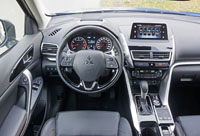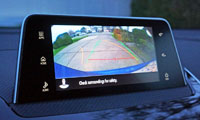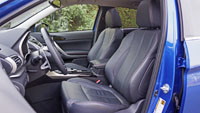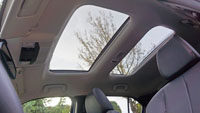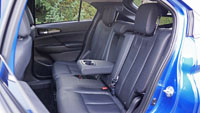
Mazda’s CX-3 has been a popular economy car alternative in Canada since arriving on the scene five years ago, even rising to third amongst subcompact SUV entries a couple of years ago.
In order to remain near the top of the charts, Mazda gave it a mild makeover for 2019, and even added some additional updates to the top-tier GT trim partway through the model year. To bring attention to these changes, which have also been included in the 2020 model, I took the opportunity to spend a week with one pre-updated 2019 CX-3 GT as well as another post-updated version, which are both featured here in this review.

Although the CX-3 has looked mostly the same since inception, Mazda steadily improved it over the years. The 2017 version carried over identically to the original 2016, but 2018 added a manual transmission to base FWD models, plus retuned the suspension for greater comfort, and added G-vectoring control as standard equipment to enhance all-weather cornering capability. Mazda also reduced its interior noise, vibration and harshness (NVH) levels, while revising the steering wheel design and the look of its primary instrument cluster. They added standard Smart City Brake Support too, a low-speed automatic emergency braking system, plus pulled additional standard and optional i-ActivSense advanced driver assistance systems down to lower trims, such as full-speed Smart Brake Support with front obstruction warning, lane departure warning, automatic high beams, adaptive cruise control, etcetera.

The mild updates for 2019 added a slightly reworked grille, taillights and wheels, while the cabin received some materials plus a new seat upholstery design partway through the year (as just noted), while the lower console of all 2019 models was reorganized to accommodate an electromechanical parking brake. Blind spot monitoring was also made standard for 2019, while the top-tier GT trim received real leather in place of leatherette and everything standard from the previous year’s Technology package, which included satellite radio, auto high beams, and lane departure warning.
The 2019 CX-3’s Skyactiv-G 2.0-litre four-cylinder engine received a 2-horsepower bump as well, increasing total output to 148 horsepower. While torque has remained at 146 lb-ft for the SUV’s five-year tenure, the power upgrade continues unchanged into the 2020 model year, as does the rest of the CX-3 in its entirety.

Just in case you’re wondering, the difference in power from 2018 and 2019 equals 1.35 percent, which is imperceptible without electronic detection. I certainly couldn’t tell the difference from one model year to the other, and have been perfectly happy with the CX-3’s performance since day one, always finding it a fun SUV to drive.
As for fuel economy, the 2019 CX-3 gets a 8.8 L/100km city, 7.0 highway and 8.0 combined rating when its sole engine is mated to its base manual transmission and FWD, while the automatic with FWD yields an estimated 8.3 in the city, 6.9 on the highway and 7.7 combined, and the auto with AWD gets a claimed 8.6, 7.4 and 8.1 respectively.
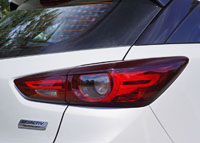
This single engine is included with all trims, incidentally, while the base GX once again comes standard with a manual gearbox and FWD, and is optional with a six-speed automatic in either FWD or the automaker’s i-Activ AWD. The mid-range GS comes standard with the automatic and is optional with AWD, whereas the GT features the automatic and AWD as standard equipment. The CX-3 base price comes in at just over $21k (plus freight and fees), while my fully optioned test model starts at a little more than $31k (see all prices, including trims, packages and standalone options on our 2019 Mazda CX-3 Canada Prices page). Those prices stay the same for 2020, by the way, although you can save up to $2,000 in additional incentives for the 2019 CX-3, while average member savings have in fact been $2,166 according to the just-noted page. The 2020 Mazda CX-3 gets up to $600 in additional incentives, says its 2020 Mazda CX-3 Canada Prices page, while average member savings hold steady at $2,166. With savings like this, a CarCostCanada membership will pay for itself quickly.
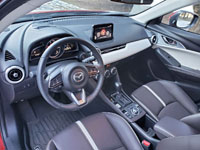
Steering wheel-mounted paddles get added to the Skyactiv-Drive automatic transmission in both GS and GT trims, which certainly increase driver engagement, while the GT also increases its wheel size from 16s 18-inch alloy rims on 215/50R18 all-season rubber, aiding grip when pushed hard. Although the CX-3 only employs a semi-independent torsion beam rear suspension setup, with the usual MacPherson strut up front, handling is very good for the class, while a power assisted rack-and-pinion steering system delivers immediate response and fairly good feedback. Since Mazda softened its ride, the CX-3 is much more comfortable on uneven pavement too, which really helps enhance overall refinement.
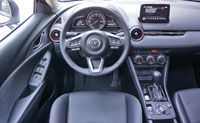
On that note the CX-3 is really nice inside, which of course is expected from Mazda that’s one of the most premium-like brands in the mainstream volume sector. Of course, the little SUV isn’t as upscale as the new CX-30 or CX-5, particularly in the latter model’s Signature trim that gets cloth-wrapped A pillars, real wood trim and other niceties, this smallest model not even applying pliable synthetic to the dash-top and door uppers, but its instrument hood is quite luxurious thanks to stitched leatherette, while the centre section of the instrument panel gets a contrast-stitched and padded leatherette or microsuede bolster across its middle, and leatherette knee protectors are fixed to the insides of the lower console, plus leatherette or suede adorns the door inserts.
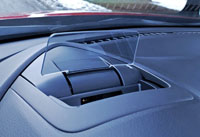
Before delving further, I should explain why some CX-3 GTs feature leatherette trim and others get microsuede. Early 2019s received stitched leatherette on the instrument panel bolster and door inserts like previous model years, my Soul Red Crystal painted tester an example of this interior treatment, but Mazda updated these areas to grey Grand Luxe Suede midway through the 2019 model year, which can be seen in my Snowflake White Pearl tester. Now the Alcantara suede-like material is the only treatment on these surfaces for the 2020 CX-3 GT.
So if you’ve been checking out the CX-3 at your local dealer (and there’s no shortage of 2019s thanks to the recent downturn of nearly everything), you’ll now understand why some have the leather look and others are plusher. I like both, but the psuede feels more opulent, and it’s also the newest trim so may help with resale.
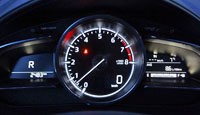
The mid-year upgrade changed the GT’s upholstery too, my red tester boasting stunning two-tone brown and cream perforated Cocoa Nappa leather that’s no longer available for the 2020 model year, whereas my white tester featured the same perforated black leather with grey piping as found in the new 2020. Mazda will be happy to sell you a CX-3 GT with Pure White leather instead, this no-cost option available for both years. Try to find this level of variety, let alone luxury in competitive subcompact SUVs and you’ll be stymied, Mazda a cut above when it comes to personalization.
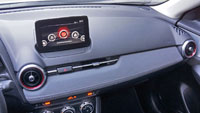
Other than upholsteries and trims the early and late arrival CX-3 GTs are mostly identical, other than the circular dash vents that feature black inner bezels in the early model and metallic red in the later one, but the horizontal strip of vents that elegantly underscores the aforementioned instrument panel bolster is the same in both, while all vents are highlighted by a very authentic looking satin-finish aluminum.
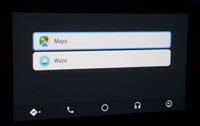
There’s a lot more of this premium-look metal throughout the interior, surrounding the analogue and digital primary instruments, embellishing the third steering wheel spoke, ringing the centre dash-mounted infotainment display, as well as the lower console-mounted controls used for inputting data. This features a beautiful knurled metal-edged dial and another smaller one for adjusting audio volume, while additional quick-access switchgear includes buttons for the main menu, audio system, navigation, radio favourites, and the back button. The three-dial auto climate control system features some knurled metal detailing too, once again making the CX-3 look and feel more upscale than its price suggests it should.
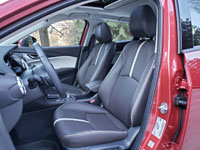
The infotainment system in mind, Mazda was slow to integrate Apple CarPlay Android and Auto into the CX-3, which means if you’d like to have either you’ll be required to opt for the late 2019 arrival or a 2020. The 7.0-inch centre touchscreen display in my early 2019 is otherwise good, and included navigation, Bluetooth phone connectivity with streaming audio, a great sounding Bose audio system with seven speakers, satellite and HD radio, text message reading and responding capability, and the list goes on, while the newer version includes all of the above plus the two smartphone applications, and Android Auto worked as well as Android Auto works.
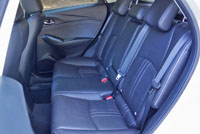
Speaking of features, 2019 and 2020 CX-3 GTs include auto on/off LED headlamps with adaptive cornering as well, plus auto-levelling and the previously noted automatic high beams, while LED fog lights, LED rear combination tail lamps with signature details, and additional chrome trim improve the exterior, while proximity keyless access let’s you inside, and a 10-way powered driver’s seat with memory provides comfort and support. Atop the gauge cluster is an Active Driving Display that powers a transparent panel up to reflect key information instead of having it projected right onto the windshield like a regular head-up display unit, while some of that info includes traffic sign recognition. Up above, an auto-dimming rearview mirror makes driving at night easier while a powered glass sunroof lets more light in during the day.
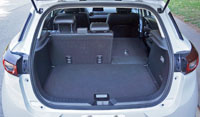
Features pulled up from lesser trims worth noting include pushbutton start/stop, rain-sensing windshield wipers, a heatable leather-wrapped steering wheel rim, a leather-wrapped shift knob, a wide-angle backup camera (not including dynamic guidelines), Aha and Stitcher internet radio, dual USB charging ports, three-way heated front seats, an overhead console with a sunglasses holder, a folding rear centre armrest with cupholders, a removable cargo cover, tire pressure monitoring, all the expected active and passive safety features, plus more.
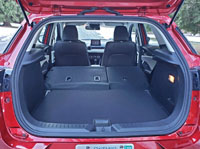
The just-mentioned 10-way power seats plus the CX-3’s tilt and telescoping steering column provided adequate adjustability for good comfort and control without forcing me to cramp my longer than average legs (for my height), while the rear seat was spacious enough even when I had the driver’s seat pushed back farther than some would require. It’s just important to remember that the CX-3 is Mazda’s smallest, and their larger CX-30, CX-5 and CX-9 SUVs offer a lot more space for getting comfortable.
Of course, the CX-3 provides less cargo space than these larger Mazdas too, with just 504 litres available behind its 60/40 split-folding rear seatbacks, and even less at 467 litres in GT trim due to the audio system’s subwoofer, while laying the rear seats flat results in a maximum of 1,209 litres in the two lower trims or 1,147 litres in the GT.
After everything is said and done, I think you’d be satisfied with any Mazda CX-3 trim, being that it’s a good looking, fun to drive, efficient and impressively refined subcompact crossover SUV. Of course, it has many opponents, many that add size and roominess like Mazda’s own CX-30, but for those wanting a smaller SUV it’s hard to beat the CX-3.
Story and photo credits: Trevor Hofmann
Photo Editing: Karen Tuggay

